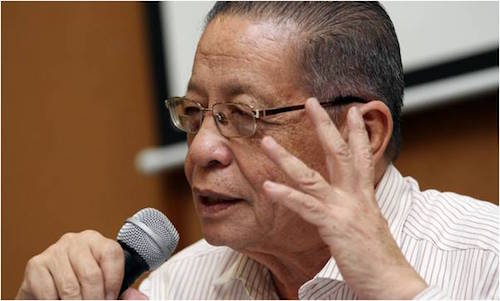Lim Guan Eng: the pup Kit Siang sold to Penangites
The Third Force
The Kedah Menteri Besar controversy has finally given way to the realisation that scheming against your boss doesn’t pay. And if there’s one thing that we’ve learned towards the tail end of the crisis is that sometimes Lim Guan Eng can be quite the nerd.
“Not many people are aware that Prime Minister Dato’ Seri Najib Tun Razak had tried to prevent the Kedah crisis. Realising that Kedah division leaders were unhappy with Dato’ Seri Mukhriz Mahathir, Najib offered him a deputy minister’s post, which the former rejected in no uncertain terms. It is believed that both Mukhriz and his father, Tun Dr. Mahathir Mohamad, had planned the rejection to politicise what had by then become a controversy. Sources revealed that both father and son have long been talking of a new multiracial affair that would go against UMNO during the 14th general elections.”
Reeling under the pressure of his detractors, the Penang state chief minister made a mockery of his court eleven days ago when he gave UMNO a bad press over the crisis. On the 25th of January 2016, Guan Eng spoke his oracle against the Malay-based party with dark words that were tucked into the opposition coalition’s media apparatus – Malaysiakini (Kini), and The Malaysian Insider (Insider).
“…an even fiercer war is definitely going to happen in Kedah,” he said, forthcoming.
Moving on, he hinted of a crack-up and gloomier days ahead for UMNO, and that was just the appetiser. With zealous intent, he waged forward with forecasts of an impending doom, conveniently dwarfing an ongoing leadership crisis that has since taken a toll on his popularity ratings in his current political base, Penang.
“On the 23rd of November 2015 and at a DAP convention, Chai Leng Park representative Shamsher Singh Thind questioned Guan Eng’s rationale for purchasing a Mercedes S Class for official use. According to Shamsher, Guan Eng had sanctioned the purchase despite having criticised the Terengganu state government in 2008 for doing the same. Some days later, Shamsher, who is believed to represent a sizeable faction of disgruntled party members and state assemblypersons, lamented how the post of chief minister was being given to an outsider and not a Penang born.”
Even the controversial land swap deals and the soaring prices of property in Penang got worse placements in both Kini and Insider than did the Kedah crisis. These issues aren’t just marginalising the island Malays – largely bracketed in the middle-income level – they’re threatening to turn the island state into a club for billionaire developers.
And now that the Kedah crisis is over, both Kini and Insider are giving us the run-around with ‘aftershock editorials’, stretching the report on Dato’ Seri Mukhriz Mahathir’s resignation as far into the domains of shock and unrest as it can go.
But the DAP secretary-general’s forecasts merely teased into mainstream narratives on battles that had already been waged across the UMNO bipartisan fence. What this implies is that the party could just as well have contained the issue with moral prudence and a wiser media apparatus – but it didn’t.
Ever since Dato’ Ahmad Bashah, the deputy chairman for Kedah UMNO, rallied 14 state division leaders into a press conference to seek the Prime Minister’s intervention in retiring Dato’ Seri Mukhriz Mahathir, nothing else that was Malaysia mattered to the mainstream media.
Both Kini and Insider immediately hopped onto the bandwagon that was UMNO and began cranking out editorial after editorial on the two warring factions – team A, which comprised Tun Dr. Mahathir and his supporters, and team B, consisting of the Prime Minister’s apologists. Each team was labouring to outwit one another and were even seen clawing into each other’s hair.
But when it came to reality, their versions were mirror opposites. According to team B, Mukhriz was being asked to step down in spite of the fact that he was Mahathir’s son. Team A would have had the same version if not for a twist – that it wasn’t in spite of, but because of the fact that he was Mahathir’s son, Mukhriz was being asked to resign.
Whatever the version, it didn’t stop Lim Guan Eng from rambling on and on.
“We did not do anything…but Kedah is already having a civil war.”
Frankly, the Penang chief minister laid it on the line – he literally did not to anything. And if there’s any reason why he didn’t, it’s because he himself has been kept busy – by many of his party members, who apparently, want him to step down as Chief Minister of Penang.
On the 28th of November 2015, a group of 40 odd protesters, believed to be under the influence of disgruntled state assemblypersons from DAP, rallied against the chief minister outside the state’s administrative hub, demanding for his retirement.
“The protesters were believed to represent disgruntled state DAP assemblypersons and members who sincerely wanted an end to Guan Eng’s dictatorial rule”
Placards included those that read “Children of Penang Support Chow Kon Yeow as Penang Chief Minister” and “Lim Guan Eng Balik Melaka.” The same protesters turned up the very next day outside another venue where a state DAP delegates’ congress was being held and demanded the same – that Guan Eng hand over his post to senior executive councillor Chow Kon Yew and return to his former electoral base in Malacca.
Anti-Guan Eng protests have been percolating for some months now, albeit in different shades. On the 20th of November 2015, (then) Penang DAP Organising Secretary Teh Yee Cheu courted scorn from the Chief Minister when he, in unprecedented fashion, voted in favour of a Barisan Nasional (BN) motion against the state’s existing reclamation policies.
The vote was seen by many as a ballot issue on the mores of prudence and virtue in governance, which according to many Penangites, was lax in the Guan Eng administration. More than being a slap on the chief minister’s face, the vote was seen also as a reflection of the inordinate discontent that has been rocking his Administration, a shortcoming the chief minister was desperately seeking to overcome.
The state government has long been accused of reclaiming land and selling or delivering them in parcels to private developers to compensate for real property projects on the island. But these projects have been driving property prices into a bubble that may rudely jolt islanders once it bursts, which may be sooner than Guan Eng thinks. The ballooning of the bubble in recent months may have put property investment by middle-income groups and particularly, the island Malays, into a stasis it may never recover from.
On the 12th of November 2015, Pulau Betong assemblyperson Muhammad Farid Saad said it as it is. Pointing out how the state government had dished out a parcel of reclaimed land that was otherwise meant for infrastructure projects, he may have shown us just how arrogant and opportunistic the state government was under Guan Eng’s leadership.
“Penang Development Corporation (PDC) had reclaimed 1,120 acres of land spanning from the first Penang Bridge to Batu Maung to cater for infrastructure development of a 9.7km Bayan Lepas Expressway and industrial land, but the chief minister has conveniently sold a parcel of this reclaimed land totalling 103 acres to Ivory Bhd. for RM1.02 billion.”
“For the years 2012, 2013 nd 2014, land sales brought in RM206.1 million, RM210.8 million and RM300.2 million respectively – the LSS Report”
According to Farid also, the state government had sanctioned a land swap deal that may have partially financed the construction of an undersea tunnel facility by Zenith-BUCG, a joint-venture company that in 2013 had been awarded the project amid protests over its viability.
But the problem was this – 60 acres of the parcel that had been bartered constituted land, which under terms of a separate agreement, was to be returned to the state for infrastructural development projects. These allegations, along with others by Farid, fuelled speculation over the state’s reclamation policies and acts of wilful negligence by its chief minister, Guan Eng.
A recent dive into the state’s financial records may have further corroborated Farid’s claims. According to an editorial that surfaced on the 24th of January 2015, the state government may have balanced its books on some highly questionable deals – some of which generated revenue that helped run the budget surpluses Guan Eng has so often bragged about.
Islanders were left feeling wrong-footed when it was revealed how acres and acres of land had been parcelled out by the state government to private developers at unprecedented rates. The questionable deals raked in revenue that, based on the report, was close to cracking the 10-digit psychological mark in just seven years since a DAP-led coalition took over the administration of the state.
When Teh voted in favour of the BN motion late last year, he inadvertently resonated with a plea by islanders for land reclamation to be regarded a heritage concern. But what Teh got was a wrench – thrown right at his face, right after the vote. Many believe that it was Guan Eng who had pitched the shot, demanding both Teh’s apology and his unconditioned resignation from his post.
Yet, one would be hard-pressed to find evidence of the Chief Minister’s dictatorial ways in a media apparatus that seems to be advancing an unspoken cause – a west coast dominion. The cause, envisioned by senior DAP stalwart Lim Kit Siang back in the seventies, cuts a trench to post-Malaysia Singapore, which, under the leadership of the late Lee Kwan Yew, had instructed a young Kit Siang to return to Malaysia and wrest control of DAP from its then Secretary General, Devan Nair.
“Back in the seventies, a younger Kit Siang was brought into the idea of a northern metropolis and a feeder entrepôt for ports along the Malacca Straits and in particular, Singapore. The idea consolidated into a west coast agenda, central to which was a DAP led dominion that was to be headquartered in Penang and stretched all the way through two pivotal port bearing states – Selangor and Johor.”
But more of that in another article, at a later date.







